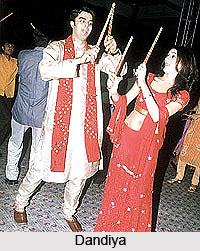Dandiya the Indian Folk dance has been successfully preserved in Gujrat keeping in mind its rich tradition of song, dance and drama. Dandiya is one of the important dance forms among them. The dandiya is the chief folk dance of Gujarat, which is usually performed in groups, wherein young men and women dressed in colorful costumes, dance in circles with multihued sticks in their hands to the lively beat of drums. This festival is very popular during the Navratri season in October.
 Ideally two circles formed by young people move around an imaginary circle in clockwise, anti-clockwise and diagonal directions with two sticks called "dandiyas" held in their hands, which they strike alternately to the right and left. Dandiya is a very energetic and playful dance providing opportunity for acting and exchanging messages through eye contact.
Ideally two circles formed by young people move around an imaginary circle in clockwise, anti-clockwise and diagonal directions with two sticks called "dandiyas" held in their hands, which they strike alternately to the right and left. Dandiya is a very energetic and playful dance providing opportunity for acting and exchanging messages through eye contact.
The uniqueness of dandiya from the rest is its use of colourful, musical sticks, its dress code, the scope it offers for improvisation, innovation and creativity, and the massive number of dancers in any single programme. As for sticks, they were traditionally made of bamboo. However, nowadays these sticks come in a variety of colours and kinds clattering of which should be in tune with the music played and at rhythmic intervals, are the markers of time.
Another identifiable feature of dandiya is its dress code. The dress code for women and men are different. For women it is a three-piece ghagras, cholis, and odhni. Men dress up in matching colourful traditional dhotis and aangrakha or kurtas with loads of mirrors on the dress.
Dandiya was secular in its origin and has intimate relation with the common man"s life of the day. It was originally performed only by men with long sticks in their hands and was designed to serve as learning modules for practice of footwork for sword fighting. This dance with fast movements was a dance of martial arts variety. Further, it was accompanied by a percussion instrument `meddale` drummer who stands at the centre of the circle and leads the dance with the rhythmic beats. The public performance of dandiya, corresponds to the agricultural cycle of the region.
This folk dance of India enlaced with its entire colour, magic, verve and zest has now crossed the boundaries of pits, galleries and country borders whilst reaching the western world to illustrate the true colour of India.



















